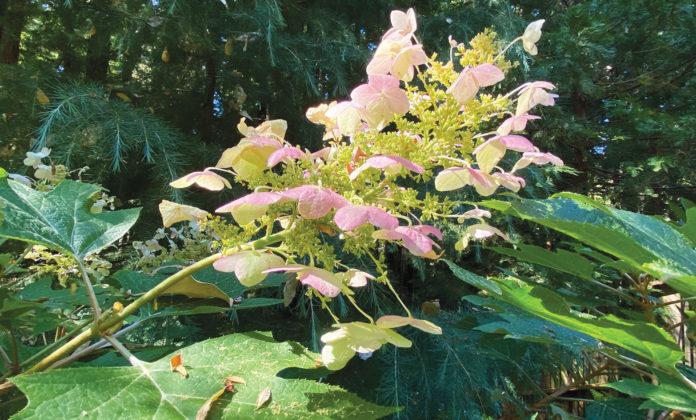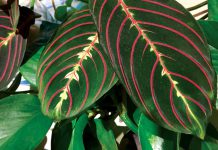If you see a recurring theme in my columns about growing successfully in a shady garden, it’s because my last three houses have all had a lot of shade. You’d think I’d have so much experience by now that all my plants would bloom their heads off, shade tolerant veggies would grace my table and everything would be lush and productive at this time of year.
Well, I have to tell you that only one of my four hydrangeas set flowers this year and I’ve given up trying to grow veggies. A harvest of 12 green beans just wasn’t worth the space and effort. So here are some tips if you garden in shady conditions or morning shade with the dreaded short, hot blast of afternoon sun.
Looking for shade tolerant flowering shrubs to cut for bouquets? Fragrant daphne odora is a wonderful small shrub. For summer fragrance, grow Carol Mackie or Summer Ice daphne. Sweet olive or osmanthus fragrans is a large evergreen shrub or small tree with blooms that smell like apricots in winter.
Oakleaf hydrangea (hydrangea quercifolia) also looks good in shade or sun. Showy leaves resembling oaks, turn bronze or crimson in the fall. Huge white flower clusters bloom in late spring through summer and turn pinkish as they age. They are attractive if left on the plant for the rest of the season.
Looking around my own garden one of the plants that does well in sun or shade is Fringe Flower (loropetalum chinense). This handsome evergreen shrub comes in two versions—green foliage with white flowers or burgundy foliage with raspberry flower clusters. Flowering is heaviest in the spring but some bloom is likely throughout the year. You can prune loropetalum to any size but please don’t turn it into a tight ball and ruin its shape. Another plus is that it is not attractive to deer.
Lily of the Valley shrub (Pieris japonica) looks good in shade or sun. An evergreen shrub with year round interest, this plant blooms early in late winter through early spring and is covered with little bells for several months. Starting in fall when reddish flower buds appear through summer as the new foliage emerges with a red tint there is always something attractive happening with this plant. It’s deer resistant also.
Plants to grow in dry shade areas include liriope, coral bells, bergenia, mahonia, nandina filamentosa, fragrant sarcococca, clivia and Viburnum “Mariesii.”
Chinese Ground Orchid (Bletilla striata) is another of my favorite plants for shade. A natural companion for ferns and wildflowers, this plant is tougher than it looks. Vivid, magenta blooms resembling small cattleya orchids emerge on long stalks for about seven weeks in the spring.
California native Western Wild Ginger and Pacific Coast Iris grow well in shade also as do Western Sword fern and Woodwardia ferns. Coral Bells, columbine, lewisia, lobelia cardinals, ribes, salvia spathacea, fragraria, dicentra, calycanthus, philadelphus or Mock Orange and carpenteria to name just a few.
What veggies can you grow in shade? Without much sun, plants photosynthesize less and produce less sugar. On the bright side—no pun intended—shade does offer some benefits. Gardens in the shade don’t have to be watered as often and weeds don’t grow as quickly.
Root crops and leafy plants can tolerate more shade than fruiting crops. Beets, carrots, celery and turnips will grow quite happily in partial shade. So will shallots and bunching onions, cilantro, garlic, chives, kale, leeks, parsley and thyme. Leafy plants can tolerate partial to light shade because their leaves grow larger to absorb the sunlight the plants need. In very light shade areas concentrate on leafy green like Swiss chard, lettuce, spinach, radishes and tarragon.
Shade tolerant vegetables for your brightest spots—the partial shade areas—include beans, peas, potatoes, pumpkin, summer squash and early maturing tomatoes like Early Girl, Stupice, San Francisco Fog, Isis Candy as well as other cherry tomatoes. Corn and peppers will be lankier and bear later and only modestly in partial shade.
Shade can be decidedly helpful to some crops. Leafy greens will be more tender and succulent, without the bitterness they tend to acquire when conditions are too hot. A combination of a bit of afternoon shade and an abundance of moisture will help cut-and-come-again crops like broccoli, lettuce, cabbage and celery stay in good condition longer in hot weather.
Whatever plants you grow in your shady garden, be sure not to crowd them. Plants tend to sprawl there and if placed too close together they will compete for available light. Place your vegetables plants wherever they will get the most light even if it means putting different crops in separate places. A small harvest is still better than no harvest at all.
Sure, every garden is different—different look, different soil, different degree of shade—but it’s surprising how often one of these plants plays a starring or supporting role in a vignette or border.
Those of us who live under the trees know a shady garden is a pleasant place to spend time on a hot summer day. Don’t give up if your garden is like mine. There’s a solution for everything.
Jan Nelson, a landscape designer and California-certified nursery professional, will answer questions about gardening in the Santa Cruz Mountains. Email her at ja******@*ol.com, or visit jannelsonlandscapedesign.com.












